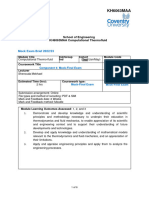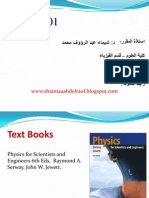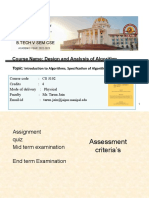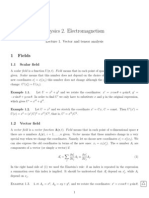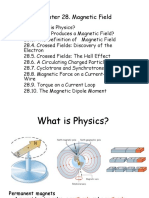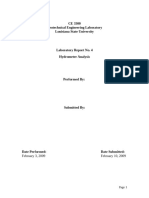Internal Verification of Assignment BR Iefs: Evaluation Criteria 1 Draft Final Brief
Internal Verification of Assignment BR Iefs: Evaluation Criteria 1 Draft Final Brief
Uploaded by
Osama HassanCopyright:
Available Formats
Internal Verification of Assignment BR Iefs: Evaluation Criteria 1 Draft Final Brief
Internal Verification of Assignment BR Iefs: Evaluation Criteria 1 Draft Final Brief
Uploaded by
Osama HassanOriginal Title
Copyright
Available Formats
Share this document
Did you find this document useful?
Is this content inappropriate?
Copyright:
Available Formats
Internal Verification of Assignment BR Iefs: Evaluation Criteria 1 Draft Final Brief
Internal Verification of Assignment BR Iefs: Evaluation Criteria 1 Draft Final Brief
Uploaded by
Osama HassanCopyright:
Available Formats
Internal Verification of Assignment Briefs
Qualification BTEC LEVEL 3 Extended Diploma in Mechanical Engineering year 1
Unit No. 4 Title Mathematics for Engineering Technicians
Outcome No. 4 Title Be able to use elementary calculus techniques
Assignment No. 4 Title Calculus Techniques
Part 1 of 1
Assessor Name Ausama Ibrahim Hassan
Internal Verifier Ezz Eldin Hassan
Evaluation criteria
or
1
st
draft
Final
Brief
1 Is the assignment word processed?
2 Is there a title to the assignment?
3
Is there reference to the unit and the learning outcomes being
assessed, including outcome statements?
4
Is there a suitable scenario/introduction that is appropriate to the
level of the student?
5 Is it clear what evidence the student needs to generate?
6 Is the timescale for the assignment appropriate?
7
Do the grading criteria relate to the outcome(s) being assessed and
the P/M/D criteria from the qualification specification? (where
appropriate)
8 Is the assignment appropriate for the level of the students?
9 Is the hand-in date (Completion Date) clear?
10 Overall is the assignment fit for purpose?
Comments
Assessor's Signature Date
IV's Signature Date
Sharjah Institute of Technology
Assessment Activity Front Sheet
(This front sheet must be completed by the STUDENT where appropriate and included with the work submitted for assessment)
Students Name: Assessors Name:
Ausama I.
Hassan
Date Issued: /4/2012 Completion Date: /4/201 Submitted on: / /
Qualification BTEC LEVEL 3 Extended Diploma in Mechanical Engineering year 1
Unit No.: 4 Unit Title: Mathematics for Engineering Technicians
Outcome No. : 4 Outcome Title: Be able to use elementary calculus techniques
Assignment No.: 4
Assessment Title: Calculus Techniques
Part: 1 of 1
In this assessment you will have opportunities to provide evidence against the following criteria. Indicate the
page numbers where the evidence can be found
Criteria
Reference
To achieve the criteria the evidence must show that the
student is able to:
Tick if
met
Page
numbers
P10
Apply the basic rules of calculus arithmetic to solve three different types of
function by differentiation and two different types of function by integration.
D1
Apply graphical methods to the solution of two engineering problems
involving exponential growth and decay, analyzing the solutions using
calculus.
D2
Apply the rules for definite integration to two engineering problems that
involve summation.
Declaration
I certify that this assignment is my own work, written in my own words. Any other persons work included in my assignment is
referenced / acknowledged.
Students Name Students Signature:
Date:
Internal Verifiers approval to use with students
IVs Name: Ezz Eldin Hassan IVs Signature Date
Criteria Achieved
P10 D1 D2
Front Sheet
In your work as a mechanical technician, you may have to deal with a variety of
calculations and manipulations that need a knowledge of circular measurements,
triangular measurements and mensuration. As part of your course you are
required to prove your abilities to do such algebraic methods of calculations
and manipulations through solving the following tasks:
Task 1: [ P10 ]
A.
1.
The length, l , of a rectangular area is 4m longer than its width, w. find the
derivative of the length of the diagonal, D, with respect to, w.
2.
Find the slope of the line tangent to the curve :
x y 3 sin 2 =
at
3
t
= x
3.
If :
t
e t x
2
5 ) ( =
Show that:
x
dt
dx
2 =
Then find the value of
dt
dx
and x , , at t = 2.
B.
1.
Newtons law of cooling states that the rate at which an object cools is directly
proportional to the difference in its temperature, T, and the temperature of the
surrounding medium. By use of this law, the time, t (in minutes) a certain metal
object takes, in an experiment, to cool from C
o
80 to C
o
50 in air at
C
o
25 is found to be:
}
=
50
80
25
8 . 9
T
dT
t
Find the value of ( t ).
2.
Find (y) as a function of (x):
( )dx x x y . 6
3 2
}
+ =
Given that:
7 ) 0 ( = y
Task 2: [ D1 ]
A.
Tool life is the time a tool can be reliably be used for cutting before it must be
Either discarded or repaired such as lathe bits which are regularly reground after
use.
A tool life equation was developed by Taylor, and is outlined below,
C VT
n
=
Where,
= V cutting Velocity in feet per minute
= T tool life in minutes
= n a constant based on the tool material
= C a constant based on the tool and work
If in turning of a 2 cm diameter steel rod by a given cutting tool (material
and geometry) at a given machining condition under a given environment
(cutting fluid application), the tool life decreases from 80 min to 15 min.
due to increase in cutting velocity,
from 60 m/min to 140 m/min. according
to the data measurements below:
Cutting Velocity, ( ) V
meter /minute
60
85
100
110
120
140
Life Time, ( ) T
minutes
80
40
30
24
20
15
1. Find the cutting velocity in m/min. and in RPM (Rounds per Minute)
at which the life of that tool under the same condition and environment
will be 25 min.?
2. Plot ( T log ) versus ( V log ) and hence find the constants ( n )and ( C ).
3. Analyze the results by applying the appropriate method of differential
calculus to check the results that you have already found by using
a graphical method
B.
To charge a capacitor, just connect it to a potential (like a battery).Immediately
after closing the switch, current flows and charges up capacitor exponentially .
The equation for the voltage across the capacitor is given by:
|
|
.
|
\
|
=
t
t
C
e E V 1 , where, RC = t and:
Ohms in ce rsis R . . tan =
Farad in ce capaci C . . tan =
1. Plot (
E
V
C
) against (t) for the following values of (t):
t t 1 t 2 t 3 t 4 t 5
E
V
C
2. Find the slope of line tangent to the graph at time ( t 1 = t ) by drawing it on the plotted graph
at the specified point and calculating its slope from the graph (graphical method).
3. Find the slope of line tangent to the graph at time ( t 1 = t ) by use of differential calculus.
4. Compare the results of the two methods found in (2) and (3) of part ( B)of Task 2.
Task 3: [ D2 ]
A.
1. By using definite integration derive a formula for the moment of inertia
of a disc of radius(R), thickness (t) and density ( ) rotating about its
center.
2. Find a formula for the disc radius of gyration in terms of its geometric
radius (R).
3. Calculate the moment of inertia and radius of gyration of the disc using
the formulae that you found above if:
mm R 300 =
mm t 50 =
3
/ 7800 m kg =
B.
If the velocity (one dimensional) of a particle moving with uniform acceleration is
given by:
at v t v + =
0
) ( (1)
Where,
= ) (t v The velocity of the particle at time (t).
=
0
v The velocity of the particle at time (t=0).
= a The uniform acceleration of the particle.
1. Find a formula for the area under the velocity-time graph from time
(t = 0 sec) to time(t = T sec) by using definite integration method.
2. Calculate the area under the graph you have already found in part (1) of (B)
if:
2
/ 10 s m a =
s m v / 50
0
=
s T 20 =
Hint :
dt
ds
t v = ) ( , where ( = s distance covered in time (t)).
Assessment Feedback Form
(This feedback sheet must be completed by the ASSESSOR where appropriate)
Feedback Sheet
Students Name:
Unit No.: 4
Assessment Title: Calculus Techniques
Criteria Achieved
P10 D1 D2
Grading Criteria Achieved:
Unit Title: Mathematics for Engineering Technicians
Outcome No.: 4
Outcome Title:
Be able to use elementary calculus
techniques.
Assignment No.:
4
Part: 1 of 1
Criteria
Reference
Assessment Criteria Achieved Evidence
Comments/feedba
ck
P10
Apply the basic rules of calculus arithmetic to solve three
different types of function by differentiation and two different
types of function by integration.
Yes/No
Calculations
and graphs
D1
Apply graphical methods to the solution of two engineering
problems involving exponential growth and decay, analyzing
the solutions using calculus.
Yes/No
Calculations
and graphs
D2
Apply the rules for definite integration to two engineering
problems that involve summation.
Yes/No
Calculations
Assessors General Comments:
Assessors Name: Ausama I. Hassan
Signature:
Date:
Students Comments:
Students Name:
Signature:
Date:
Student's Work has been Internally Verified
IVs Name:
Ezz Eldin Hassan
IVs Signature Date
You might also like
- Experiment 6 - Time Period of Physical PendulumDocument7 pagesExperiment 6 - Time Period of Physical Pendulummuzahir.ali.baloch2021No ratings yet
- Chapter 01 HomeworkDocument15 pagesChapter 01 HomeworkFatboy91100% (5)
- Linear Dependence and IndepenceDocument4 pagesLinear Dependence and Indepenceapi-318836863No ratings yet
- Internal Verification of Assignment Briefs: Evaluation Criteria or 1 Draft Final BriefDocument8 pagesInternal Verification of Assignment Briefs: Evaluation Criteria or 1 Draft Final BriefOsama HassanNo ratings yet
- TBD2A.assignment.4 .U28.Ausama.2012.Border&Qs - Final1Document12 pagesTBD2A.assignment.4 .U28.Ausama.2012.Border&Qs - Final1Osama HassanNo ratings yet
- TBD2A.assignment.3 .U28.Ausama.2012.Border&Qs.Document8 pagesTBD2A.assignment.3 .U28.Ausama.2012.Border&Qs.Osama HassanNo ratings yet
- Internal Verification of Assignment Briefs: Evaluation Criteria 1 Draft Final BriefDocument13 pagesInternal Verification of Assignment Briefs: Evaluation Criteria 1 Draft Final BriefOsama HassanNo ratings yet
- IOQP2022 PartII Questions enDocument4 pagesIOQP2022 PartII Questions enRavishankar kanakiNo ratings yet
- Https:olympiads Hbcse Tifr Res in:wp-content:uploads:2022:03:IOQP2022-PartII-Questions-enDocument4 pagesHttps:olympiads Hbcse Tifr Res in:wp-content:uploads:2022:03:IOQP2022-PartII-Questions-enjimlee.borahNo ratings yet
- Ass.2 2011 Veh Ausama (U 5) .Final2Document11 pagesAss.2 2011 Veh Ausama (U 5) .Final2Osama HassanNo ratings yet
- Reference: Sections 1.3, 1.4, and 1.5 Pre-Assignment: Engineering Calculus Peer Led Session LimitsDocument7 pagesReference: Sections 1.3, 1.4, and 1.5 Pre-Assignment: Engineering Calculus Peer Led Session LimitsMathew FreemanNo ratings yet
- Exam - Measurement Technique, ELA210, TEN1, 2023-12-08: Please Read These Instructions Carefully!Document5 pagesExam - Measurement Technique, ELA210, TEN1, 2023-12-08: Please Read These Instructions Carefully!rashed2acNo ratings yet
- CPT3701 Major Test 1Document4 pagesCPT3701 Major Test 1unisamodules5No ratings yet
- Unit 4 Mathematics For Engineering TechniciansDocument15 pagesUnit 4 Mathematics For Engineering TechniciansAli AtwaNo ratings yet
- Faculty of Science and Technology OPENBOOK EXAM: COM 123 Numerical Analysis and ComputationDocument5 pagesFaculty of Science and Technology OPENBOOK EXAM: COM 123 Numerical Analysis and ComputationJoshBarack TshinemuNo ratings yet
- Ass.1 2012 Veh Ausama (U10) .2.logocover - Plus Qs - LatestDocument12 pagesAss.1 2012 Veh Ausama (U10) .2.logocover - Plus Qs - LatestOsama HassanNo ratings yet
- Mock Exam 22 23 KH6063MAA - Computational - ThermoFluids - 2022 2023Document6 pagesMock Exam 22 23 KH6063MAA - Computational - ThermoFluids - 2022 2023Mohamed SaadNo ratings yet
- Unit 39 Further Mathematics Assign 2Document8 pagesUnit 39 Further Mathematics Assign 2Inspire UNo ratings yet
- 78f89fe0-0a86-4ee5-8467-cebfbae2f1a2Document21 pages78f89fe0-0a86-4ee5-8467-cebfbae2f1a2memiyo8434No ratings yet
- NumsolDocument6 pagesNumsolAdi SoNo ratings yet
- Alok Kumar Clas 12 Physics (1) (2) (1)Document21 pagesAlok Kumar Clas 12 Physics (1) (2) (1)ralok2568No ratings yet
- INPO2022Document4 pagesINPO2022kritikasingh181221No ratings yet
- Exam - Measurement Technique, ELA210, TEN1, 2022-12-09: Please Read These Instructions Carefully!Document5 pagesExam - Measurement Technique, ELA210, TEN1, 2022-12-09: Please Read These Instructions Carefully!rashed2acNo ratings yet
- Trifilar Suspension 1Document4 pagesTrifilar Suspension 1Ninad BhanuNo ratings yet
- Ass.2 2012 Veh Ausama (U10) .Logocover - Plus QsDocument10 pagesAss.2 2012 Veh Ausama (U10) .Logocover - Plus QsOsama HassanNo ratings yet
- Musterklausur+Lösung FMDocument11 pagesMusterklausur+Lösung FMluceromarialleNo ratings yet
- Unit 039 Further Maths A2 2018-2019CDocument12 pagesUnit 039 Further Maths A2 2018-2019CtanNo ratings yet
- Written-Report-Machine-Problem-1 - DEL ROSARIO - BSCE 2-5Document9 pagesWritten-Report-Machine-Problem-1 - DEL ROSARIO - BSCE 2-5dbringer1018No ratings yet
- Chapter 5 Optimization TechniquesDocument52 pagesChapter 5 Optimization Techniquesharoine insiderNo ratings yet
- Tarea 0-1Document16 pagesTarea 0-1Diego MontoyaNo ratings yet
- Air Drag LabDocument4 pagesAir Drag LabMaxim DurachNo ratings yet
- Unit 4 Mathematics For Engineering TechniciansDocument15 pagesUnit 4 Mathematics For Engineering Techniciansdoneill22No ratings yet
- C - Documents and Settings - Administrator - Local Settings - Application Data - Mozilla - Firefox - Profiles - GhcvulkxDocument13 pagesC - Documents and Settings - Administrator - Local Settings - Application Data - Mozilla - Firefox - Profiles - Ghcvulkxavci_16_metinNo ratings yet
- Project Report SampleDocument10 pagesProject Report SampleMelchi AsherNo ratings yet
- Phys 101 - L - 1Document20 pagesPhys 101 - L - 1drshimoNo ratings yet
- Biophysics Lab Module (4) PROJECTILE MOTIONDocument12 pagesBiophysics Lab Module (4) PROJECTILE MOTIONAko Si Vern ÖNo ratings yet
- All India Test Series (Neet) : RMCT-01ADocument14 pagesAll India Test Series (Neet) : RMCT-01AManmeet SinghNo ratings yet
- AADS sample endTermDocument2 pagesAADS sample endTermcse24013No ratings yet
- Assignment Feb 21-Ver 1Document8 pagesAssignment Feb 21-Ver 1ostaz onlineNo ratings yet
- Queuing and PERTDocument6 pagesQueuing and PERTTyronNo ratings yet
- 2020 Methods U1 2 Sem2 Exam CADocument28 pages2020 Methods U1 2 Sem2 Exam CAVarad VaidyaNo ratings yet
- 15 7 PDFDocument9 pages15 7 PDFAdityaNo ratings yet
- 0580 s11 QP 42Document16 pages0580 s11 QP 42MohammedKamelNo ratings yet
- Answer ScriptDocument5 pagesAnswer ScriptMaria KapiyaNo ratings yet
- CSEP Updated Assignment.Document11 pagesCSEP Updated Assignment.Ansh LaljiNo ratings yet
- Assignment 2Document6 pagesAssignment 2Soe Thit HtunNo ratings yet
- Unit 103 Further Mathematics For Engineering TechniciansDocument13 pagesUnit 103 Further Mathematics For Engineering TechniciansasmonovNo ratings yet
- Kedy Jan Cuanan Cengr 3140 LR1 1Document8 pagesKedy Jan Cuanan Cengr 3140 LR1 1EULLYZEN RABANALNo ratings yet
- Model Set 2 FeaDocument2 pagesModel Set 2 FeaKalai ArasanNo ratings yet
- Fluid Mechanics: Laboratory ManualDocument8 pagesFluid Mechanics: Laboratory ManualArvind PatelNo ratings yet
- EAT 339 Jan 2023 TCT QuestionsDocument10 pagesEAT 339 Jan 2023 TCT QuestionsOji Ifeanyi0% (1)
- Exam - Measurement Technique, ELA210, TEN1, 2023-11-03: Please Read These Instructions Carefully!Document5 pagesExam - Measurement Technique, ELA210, TEN1, 2023-11-03: Please Read These Instructions Carefully!rashed2acNo ratings yet
- 4-5. Mathematical Analysis of Recursive and NonRecursive TechniquesDocument59 pages4-5. Mathematical Analysis of Recursive and NonRecursive TechniquesIbrahimNo ratings yet
- 2010 08 14 NotesOnFluidMechanicsAndGasDynamics WassgrenDocument723 pages2010 08 14 NotesOnFluidMechanicsAndGasDynamics WassgrenMeera PatelNo ratings yet
- De 1234Document13 pagesDe 1234shile9011No ratings yet
- 2018 Exam Ufmfw7153 - 1705334350877Document8 pages2018 Exam Ufmfw7153 - 1705334350877family7482pleaseNo ratings yet
- KLE QP-CFD - Course AssignmentDocument2 pagesKLE QP-CFD - Course AssignmentadarshNo ratings yet
- L09-Discrete MathDocument38 pagesL09-Discrete MathOsama HassanNo ratings yet
- L07 Dis - MathDocument25 pagesL07 Dis - MathOsama HassanNo ratings yet
- Hand Out 20080904Document1 pageHand Out 20080904Osama HassanNo ratings yet
- Propositional Logic: Lecture 1: Sep 2Document58 pagesPropositional Logic: Lecture 1: Sep 2Osama HassanNo ratings yet
- Department of Foundation and General Studies - Gmath.-Assign1winterDocument8 pagesDepartment of Foundation and General Studies - Gmath.-Assign1winterOsama HassanNo ratings yet
- 10 Unit Assessment Strategy (Auto-ABC1A)Document3 pages10 Unit Assessment Strategy (Auto-ABC1A)Osama HassanNo ratings yet
- Course Code Faculty Name Co ExaminerDocument1 pageCourse Code Faculty Name Co ExaminerOsama HassanNo ratings yet
- Unit's Grade: Qualification: BTEC Level 2 Extended Diploma in Mechanical Engineering Year-1Document1 pageUnit's Grade: Qualification: BTEC Level 2 Extended Diploma in Mechanical Engineering Year-1Osama HassanNo ratings yet
- 9tasks U3 A2Document5 pages9tasks U3 A2Osama HassanNo ratings yet
- Physics 2. Electromagnetism: 1 FieldsDocument9 pagesPhysics 2. Electromagnetism: 1 FieldsOsama HassanNo ratings yet
- 8tasks U3 A2Document5 pages8tasks U3 A2Osama HassanNo ratings yet
- KS4+Electricity+ +electromagnetismDocument24 pagesKS4+Electricity+ +electromagnetismOsama HassanNo ratings yet
- 7tasks U3 A2Document4 pages7tasks U3 A2Osama HassanNo ratings yet
- Lecture Outline: College Physics, 7 EditionDocument29 pagesLecture Outline: College Physics, 7 EditionOsama HassanNo ratings yet
- Chapter 30 (1) .MagneticDocument29 pagesChapter 30 (1) .MagneticOsama HassanNo ratings yet
- Chapter 26. Current and ResistanceDocument28 pagesChapter 26. Current and ResistanceOsama HassanNo ratings yet
- Chapter 26. Current and ResistanceDocument28 pagesChapter 26. Current and ResistanceOsama HassanNo ratings yet
- Chapter 28. Magnetic FieldDocument37 pagesChapter 28. Magnetic FieldRuwani Wasana KariyapperumaNo ratings yet
- Chapter 29.magneticDocument23 pagesChapter 29.magneticOsama Hassan100% (1)
- Unit 2 The Concept of Congruence Study GuideDocument3 pagesUnit 2 The Concept of Congruence Study Guideapi-294397535No ratings yet
- What On Earth Happened Part 4Document19 pagesWhat On Earth Happened Part 4Nguyễn Hải YếnNo ratings yet
- History of The Atom - With TimelineDocument18 pagesHistory of The Atom - With TimelineBrille Anthony BunielNo ratings yet
- Y2014 - Magnetic Field Due To A Finite Length Current-Carrying Wire Using The Concept of Displacement CurrentDocument3 pagesY2014 - Magnetic Field Due To A Finite Length Current-Carrying Wire Using The Concept of Displacement CurrentXiaofang JiangNo ratings yet
- Least Square RegressionDocument13 pagesLeast Square RegressionSamiullah QureshiNo ratings yet
- Electrical Quantities (Teaching Notes)Document18 pagesElectrical Quantities (Teaching Notes)A.BensonNo ratings yet
- Failure Report October 11 To September 12 PDFDocument34 pagesFailure Report October 11 To September 12 PDFArnav SwarnkarNo ratings yet
- 1.1test MethodologyDocument14 pages1.1test MethodologyjvfcvNo ratings yet
- Zumdahls ChemistryDocument117 pagesZumdahls Chemistrykaivalyaram100% (1)
- Alternative-Refrigerants R22 GBDocument12 pagesAlternative-Refrigerants R22 GBMon PerezNo ratings yet
- UPI Leecture - DifferentiationDocument30 pagesUPI Leecture - DifferentiationNazril FarhanNo ratings yet
- Brain TeasersDocument72 pagesBrain TeasersAnuran DuttaroyNo ratings yet
- Geothermal Exploration 1Document13 pagesGeothermal Exploration 1Yoqie Ali TaufanNo ratings yet
- 34412501-Design of MC ElementDocument8 pages34412501-Design of MC Elementsmg26thmayNo ratings yet
- Jung & Pfander 2007 - Source Composition and Melting of Orogenic GranitoidsDocument12 pagesJung & Pfander 2007 - Source Composition and Melting of Orogenic GranitoidsRenata VerasNo ratings yet
- Fluid Mechanics PopellerDocument10 pagesFluid Mechanics PopellerMeghna SheoranNo ratings yet
- Bridge Watchkeeping: LO1 Regulations For The Safe Movement of VesselsDocument30 pagesBridge Watchkeeping: LO1 Regulations For The Safe Movement of VesselsChristy SajanNo ratings yet
- Coek - Info - The Critical Pigment Volume Concentration in LatexDocument14 pagesCoek - Info - The Critical Pigment Volume Concentration in Latexb3ry 17No ratings yet
- Microscope: Eyepiece LensDocument16 pagesMicroscope: Eyepiece LensAireen Emada AsibNo ratings yet
- 03 Syllabus - Aircraft Structural MechanicsDocument9 pages03 Syllabus - Aircraft Structural MechanicsjagandronepilotNo ratings yet
- Material SumittalDocument73 pagesMaterial Sumittalsubash0% (1)
- MATH2412-product Sum Identities PDFDocument4 pagesMATH2412-product Sum Identities PDFManuel Alexander Jauregui BonifacioNo ratings yet
- Example Problem Set2 F10Document8 pagesExample Problem Set2 F10irfanNo ratings yet
- Lab No. 4 Hydrometer AnalysisDocument12 pagesLab No. 4 Hydrometer AnalysisZERO100% (2)
- Computation of Perspective KRISO Containership Towing Tests With The Help of The Complex of Hydrodynamical Analysis FlowVisionDocument10 pagesComputation of Perspective KRISO Containership Towing Tests With The Help of The Complex of Hydrodynamical Analysis FlowVisionSADULLAHNo ratings yet
- MAS Folder 11 09 Wellness EN LowDocument7 pagesMAS Folder 11 09 Wellness EN Lowmas_atNo ratings yet
- KoppelDocument2 pagesKoppelLeomark RespondeNo ratings yet
- Optical RadiationDocument3 pagesOptical Radiationsipobey750No ratings yet
















